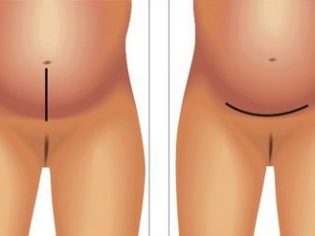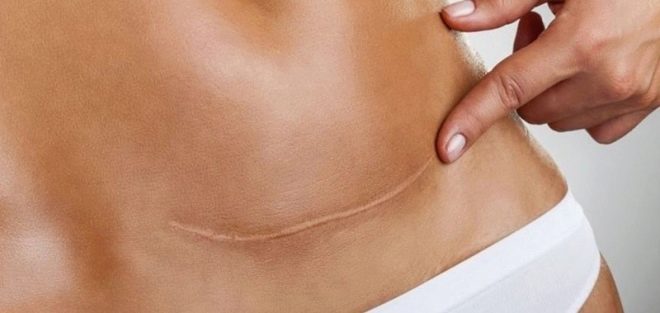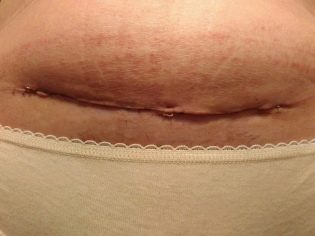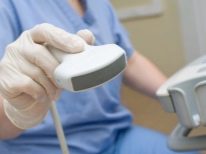How long does the seam after a cesarean section hurt and what should I do?
The seam that remains after a cesarean section is a subject of special attention and concern for women who have undergone operative labor. It is not always that the seam is even and neat, and sometimes it heals slowly and hurts for a long time. In this article, we will look at how much time the suture should heal, when it stops hurting and what to do if the scar looks strange.
How is healing done?
After a cesarean section, there are not one, but at least two seams in a woman’s external, which most often causes questions, and internal, which cannot be seen visually, since it is located inside, on the front wall of the uterus.
The external suture can be positioned vertically through the midline of the abdomen from the navel to the pubic region, and can be horizontal, located low, parallel to the pubis line. In this case, the seam does not necessarily have to be straight - there are also semi-lunar forms and J-shaped seams. The exact length and shape of the suture depends on the tactics of the operation, which for one reason or another was chosen by the surgeon. Up to 90% of all operative labor today is done with a horizontal low dissection, which in medicine has been called the Pfannenstiel section. And only a small percentage of interventions, mostly emergency ones, are performed with a vertical incision through the entire abdomen.
Terms of restoration of different seams differ from each other. Internal sutures, which are not visible to the eye, heal longer than external sutures. It takes about 2 months to restore the dissected walls of the uterus, and then the scar continues to form until about 2 years. Threads for suturing the reproductive organ are used self-absorbable and thin, these seams do not need to be processed and removed. It should be noted that they do not hurt, because the walls of the uterus are not rich in nerve receptors that can capture and transmit impulses of pain to the brain.
It is important that during the period of formation (within two years) the woman adheres to the recommendations of the doctor. Then the scar is likely to be strong, elastic and full, consisting mainly of muscle tissue.
The healing time of the external postoperative suture depends on its length, shape and method of dissection. Small horizontal seams in the lower abdomen, straight or semilunar, heal best. If there are no complications, then after 7-9 days a woman can safely remove the stitches or brackets, and after another 2 weeks, we can talk about the end of the healing of the external suture. After a month, the external scar begins to gradually brighten, and after a year, on average, it becomes less noticeable.
The vertical scar passing through the mid-abdomen heals harder and longer. It is more susceptible to inflammation, complications, its healing takes up to 60 days. For years, such a scar can remain quite bright and noticeable.
External stitches in the healing process hurt, and then you can not get anywhere. Nerve receptors of the skin, injured during the operation, the muscles of the abdominal cavity can not but signal their temporary distress, therefore, during the period of the most severe pain, women are still being anesthetized with anesthetics while still in the hospital.
After discharge in anesthesia with the normal formation of the scar is not necessary - the pain is not so strong.
What feelings can there be?
Pain in the first weeks after surgery in the postoperative suture area is a normal phenomenon. They decrease gradually.The faster the restoration of tissues, blood vessels and nerve endings in the surgical incision, the faster the pain will stop.
Often under the concept of "pain" women mean a large range of unpleasant sensations that can persist even after the scar is formed. Pain to call them is not quite right, rather, they can be described as a moderate burning sensation, tingling. The seam can remain firm to the touch for quite a long time.
A certain hardness is associated with the process of repairing damaged cells. When they recover and begin to produce enough collagen, the scar will gradually cease to be so hard. But within 2-6 months, a solid postoperative scar is considered quite normal.
For some women, the scar softens only a year later, and for some, and a few years later, it remains firmer than the surrounding tissues. Much depends on the body, weight, rehabilitation capabilities of the body, age and lifestyle.
If there is no discharge from the seam, we can say that the restoration goes without features. A small amount of bloodworm discharge is considered normal only during the first days after surgery. If after discharge a few weeks passed and there were discharges, there are complications that require compulsory examination by a doctor and treatment.
At first, women pay attention to the almost complete lack of sensitivity in the lower abdomen and pubic area. Until the nerve endings are fully restored, the numbness will be completely normal and natural. Itching in the area of the scar indicates intensive healing processes, but only if this itch is not of a strong, intrusive and pronounced nature.
Possible problems
Slow healing rates of postoperative suture can be associated with a variety of factors. Some develop complications in the maternity hospital, and they are considered early. There are also late complications that can occur within a few weeks or even months after surgery.
Infectious inflammatory processes are considered early. An unhealed suture is a wound, the edges of which are brought together with a suture or staples of medical alloy. Everyone has a risk of infection. Bacteria, viruses, fungal microorganisms, even those that are not pathogenic, that is, conditionally pathogenic, will not cause inflammation when exposed to whole skin, but in a wound they quickly turn into pests and begin to actively proliferate, causing inflammation.
Infection may be the result of poor-quality or improperly performed treatment of postoperative suture. Infections of internal sutures can be a cause of impaired hygiene, contractility of the uterus and doctor's recommendations.
On the inflammatory infectious process of internal sutures indicate temperature and abdominal pain, abnormal discharge from the genitals. External infected stitches can be recognized by a rise in body temperature, by redness, swelling of the scar area, by discharge of sucker blood or purulent secretions of all shades from yellow to gray and green from the scar. The scar itself becomes hot. Touching it causes pain.
If the scar is bleeding, although quite a long time has passed since the operation, this may indicate damage to the blood vessels. The scar becomes red, saturated lilac, hematomas appear around the scar.
The presence of unhealed sites in the scar, which women describe as "holes" in the seam, indicates the presence of fistulas. They are difficult to treat. Hernial formations on the rumen can be a consequence of neglecting the recommendations and excessively early tension of the abdominal muscles.
For a long time, a suture can not heal, not only because of an infection, but also due to immune factors - a woman's body for some reason rejects the suture material used for suturing the edges of the wound.
The most dangerous is the discrepancy seam. This is a rare complication, but it can also happen. Most often, such a problem qualifies as a late complication, when the internal suture diverges during the second pregnancy. Outer seams while maintaining integrity.
Woman's actions
On the one hand, problems with stitches do not occur so often, but on the other, each of them does not tolerate any self-treatment or connivance - a woman definitely needs to see a doctor. When planning re-pregnancy, it is important to necessarily conduct a preliminary examination of the condition of the scar on the uterus, make an ultrasound, if necessary, hysterography and hysteroscopy.
If the pain continues for two months after the operation and after this period, an ultrasound scan of the postoperative suture should be done. To do this, contact your gynecologist at the place of residence. Any complications from internal and external sutures should be excluded.
After discharge, the woman must continue to process the suture and wear a surgical gauze bandage. Zelenka is suitable for processing. She smeared the area around the wound, because it is the name of this antiseptic that many pathogenic and opportunistic bacteria are afraid of as fire. Dry seam can be hydrogen peroxide.
If you find any abnormalities, it is important not to delay the treatment to the doctor. Sex is not recommended for 2 months after surgery, and then the couple must be protected with a condom, even if sexual contact takes place during menstruation. During the formation of internal scars, it is important to exclude even a small possibility of infection in the genital tract. Then it should be protected, because the next pregnancy should occur no earlier than 2 years later, when the internal suture is strong and elastic.
A woman should avoid douching and use of women's hygienic tampons for six months.
After discharge, in order to avoid problems with seams, you should not squat, jump, make sharp turns, swing the press. For six months, the woman shows a gentle mode of activity.
On how to care for the suture after cesarean section, see the following video.























